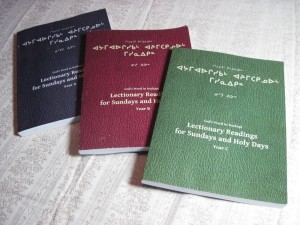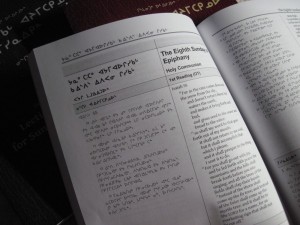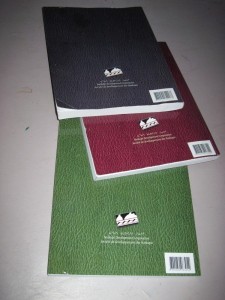Advent 2012 begins “Year-C” of the Revised Common Lectionary, the collection of Sunday Bible readings that are used in the Naskapi church. You may remember that the “Year-A” book came out almost two years ago now (the blue book) and the church has been using the “Year-B” book (the red book) for the past fifty-one weeks. Over the past several months we have reviewed and revised the remaining Old Testament verses that are contained in the “Year-C” book, and we have just printed sixty copies for distribution. On November 23 another prayer was answered: All the boxes of Year-C books arrived in Kawawachikamach in time for the first Sunday of Advent, which is December 2 this year!
Each Sunday morning, a selection from the Old Testament is read (generally somewhere between 8 and 30 verses), followed by a Psalm; then the New Testament readings: a selection from the Epistles and a passage from the Gospels. The three-year lectionary cycle is used by many denominations of the church, in which Scripture readings are arranged according to a schedule that follows the calendar of the year. This practice of assigning particular readings to each Sunday and Holy day has continued through the history of the Christian church. During the course of three years, more than seven thousand verses are read aloud to the congregation, a total that represents almost one-quarter of the Bible.
Like the other volumes of the lectionary, these books are being published and distributed by the Naskapi Development Corporation. People can drop by the office in Kawawachikamach anytime to purchase their own copy for just $10. The books are printed in diglot; that is, with the Naskapi text along side the English on each page. Readers simply look up the current Sunday in the index and turn to the appropriate page.
 Anyone outside of Kawawachikamach can order this book (and many other fine Naskapi books) from the Naskapi Resources page of the Lulu website, at this address: www.lulu.com/spotlight/naskapi. The Year C volume is a perfect companion to Year A and Year B.
Anyone outside of Kawawachikamach can order this book (and many other fine Naskapi books) from the Naskapi Resources page of the Lulu website, at this address: www.lulu.com/spotlight/naskapi. The Year C volume is a perfect companion to Year A and Year B.
Even though the Year C volume completes the series, the Naskapi Development Corporation translation and language services department continues to actively review and revise these readings each week as they are read at church, and plans to publish updated versions during the coming three-year cycle. The latest volume would make a perfect Christmas gift for any of your Naskapi family or friends.
There are several more Naskapi publication projects nearing completion in the coming months. We are currently working on the final check of a proof of the entire book of Genesis in Naskapi that should be completed in the coming weeks Lord willing, followed by the 2013 Naskapi Scripture calendar, a new Naskapi children’s book, the first book of Naskapi legends featuring Kuîhkwâhchâw (Wolverine), and the final book in the Walking With Jesus series of Bible stories on the life of Christ.
 We want to thank you for your interest and support for all of these Naskapi language projects.
We want to thank you for your interest and support for all of these Naskapi language projects.
Serving with you, Bill and Norma Jean


















